#Opuntia stricta
Text
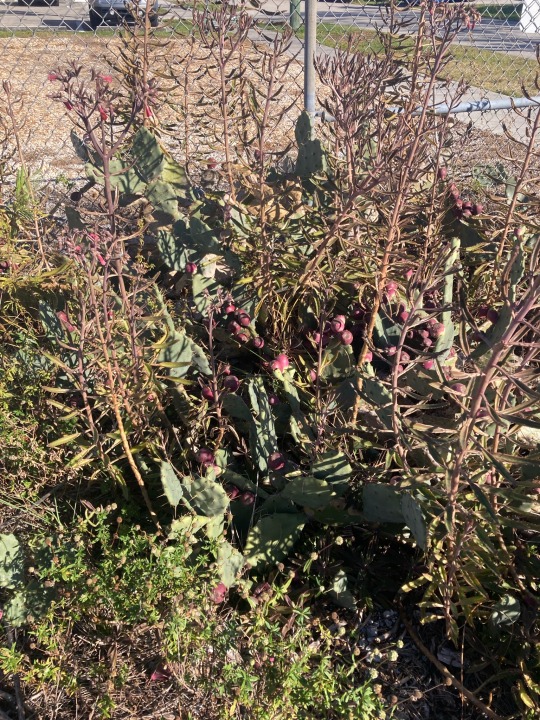
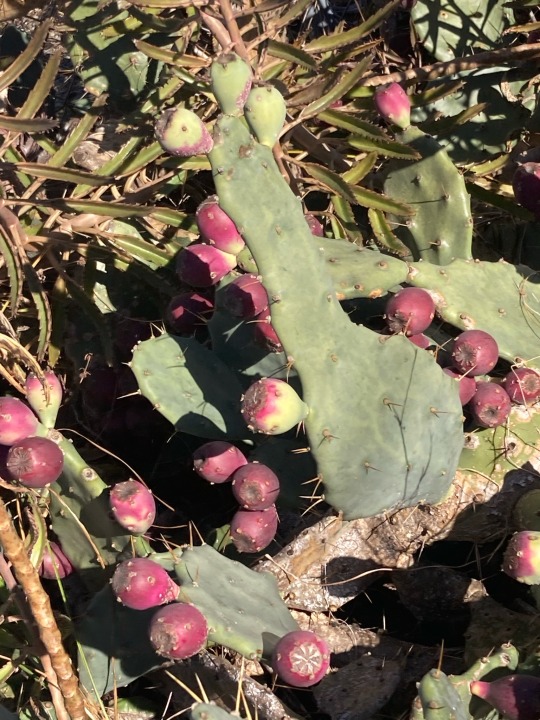
so sad it was covered in those Kalanchoes. Opuntia stricta my beloved. endangered ecosystem so i didnt take any. if anyone can help me get Opuntia stricta for myself ill give you money, ill kill for you, etc
21 notes
·
View notes
Text
Randomly Selected Botanical Terms: Glochids
Randomly Selected Botanical Terms: Glochids
The spines of a cactus are an obvious threat. They are generally sharp, smooth, and stiff; as soon as you are stabbed by one, it is immediately clear that you’ve gotten too close. Sitting at the base of the spines – or in place of spines – on many species of cacti is a less obvious, but significantly more heinous threat. Unless you’re looking closely, this hazard is practically invisible, and the…

View On WordPress
#areole#arid climates#botanical terminology#Botany#Cactaceae#cacti#cactus#Cylindropuntia#drought tolerance#glochids#Opuntia#Opuntia stricta#plant anatomy#plant ecology#prickly pears#spines#succulents#trichomes
36 notes
·
View notes
Text
The potential advantage of terrestrial CAM plants in arid environments is well illustrated by the unintentional introduction of the African prickly pear (Opuntia stricta) into the Australian ecosystem.
"Plant Physiology and Development" int'l 6e - Taiz, L., Zeiger, E., Møller, I.M., Murphy, A.
#book quote#plant physiology and development#nonfiction#textbook#cam#cam plants#cam photosynthesis#photosynthesis#photochemistry#photorespiration#prickly pear#African prickly pear#opuntia#opuntia stricta#Australia#ecosystem#Australian ecosystem#invasive species#invasive plants#arid environments#biological advantage
0 notes
Text
The Ancestors
Before divine selection could take place and the Tetrarch could begin, the deities had to choose what would inhabit their world. They would need to be adaptable enough to survive the ecological shock, and able to form a functional ecosystem from the beginning, but the rest was up to the deities’ own inscrutable choices. The majority of colonists were sourced from Earth’s Holocene epoch, but a handful of the founders were inexplicably from various other time periods. To allow more ecologically complex organisms to survive colonization, the cherry-picked settlers were introduced in successive waves, each supporting the next. The first assisted in the final steps of terraforming, the hardiest microbes starting or regulating such vital processes as oxygenation and the carbon cycle. Each wave that followed increased in size and diversity, until the Tetrarch’s founding menagerie was complete. This eclectic sample of Earth would give rise to every oddity making up the Tetrarch’s biosphere, the primordial ancestors from which all of its life descends. What follows is a list of these ancestors at the time that the Tetrarch was ready to begin, not including the myriad unicellular organisms and viruses whose descendants are also important.
Plants and Algae
-Brazilian Waterweed (Egeria densa)
-Coconut Palm (Cocos nucifera)
-Erect Prickly Pear (Opuntia stricta)
-Grasses (~ 5 species)
-Hooker’s Chives (Allium hookeri)
-Leptosporangiate Ferns (~ 5 species)
-Lithops (~ 5 species)
-Mosses (~ 5 species)
-Macroscopic Algae (~ 25 species, including Undaria and Acetabularia)
-Southern Magnolia (Magnolia grandiflora)
-Spanish Moss (Tillandsia usneoides)
-Turtlegrass (Thalassia testudinum)
Vertebrates
-African Clawed Frog (Xenopus laevis)
-Banded Knifefish (Gymnotus carapo)
-Conodonts (~ 5 species)
-Hapalops sp.
-Longspined Porcupinefish (Diodon holocanthus)
-Pacific Viperfish (Chauliodus macouni)
-Spiny Softshell Turtle (Apalone spinifera)
-Star-Nosed Mole (Condylura cristata)
Arthropods
-Atlantic Horseshoe Crab (Limulus polyphemus)
-Coccus Soft Scales (~ 5 species)
-Copepods (~ 25 species)
-Earwigs (~ 5 species)
-Goose Barnacles (~ 5 species)
-Hoverflies (~ 5 species)
-Lacewings (~ 5 species)
-Mites (~ 25 species)
-Pseudoscorpions (~ 5 species)
-Rainbow Mantis Shrimp (Pseudosquilla ciliata)
-Springtails (~ 15 species)
-Water Fleas (~ 5 species)
Molluscs
-Applesnails (~ 5 species)
-Hippurites sp.
-Sea Angels (~ 5 species)
-Sea Butterflies (~ 5 species)
-Venus Clams (~ 5 species)
Other Animals
-Arrow Worms (~ 5 species)
-Brittle Stars (~ 5 species)
-Clitellate Worms (~ 15 species, including leeches, earthworms, and naidids)
-Demosponges (~ 10 species)
-Dugesia Planarians (~ 5 species)
-Nematodes (~ 300 species)
-Rotifers (~ 5 species)
-Tardigrades (~ 5 species)
-Velvet Worms (~ 5 species)
Fungi
-Collared Earthstar (Geastrum triplex)
-Lichens (~ 5 species)
-Molds (~ 50 species)
#biology#fantasy#ecology#speculative biology#spec evo#spec bio#speculative evolution#the tetrarch#seed world#worldbuilding#artificial selection
6 notes
·
View notes
Text
How to Grow Prickly Pears in Florida
Growing prickly pears, also known as Opuntia cacti, in Florida can be a rewarding experience.
Here are some tips and methods to help you successfully grow prickly pears in Florida:
Choose the Right Variety: Select a prickly pear variety that is well-suited for Florida's climate. Some recommended varieties include Opuntia ficus-indica and Opuntia stricta.
Sunlight Requirements: Prickly pears thrive in full sunlight, so choose a location in your garden that receives at least 6-8 hours of direct sunlight each day.
Soil Preparation: Prickly pears prefer well-draining soil. Ensure that the soil has good drainage by adding organic matter, such as compost or well-rotted manure, to improve soil structure and fertility.
Planting: Plant prickly pears in the spring when the soil has warmed up. Dig a hole slightly larger than the root ball and place the plant in the hole, making sure it is planted at the same depth as it was in the nursery pot. Backfill the hole with soil and gently firm it around the plant.
Watering: Prickly pears are drought-tolerant plants but still require regular watering, especially during dry periods or when newly planted. Water deeply and then allow the soil to dry out before watering again.
Mulching: Apply a layer of organic mulch around the base of the prickly pear plants to help conserve moisture, suppress weed growth, and regulate soil temperature.
Pruning: Prickly pears can become quite large and may require occasional pruning to control their size and shape. Prune back any damaged or diseased pads or branches, and be sure to wear gloves to protect your hands from the spines.
Fertilization: Prickly pears generally do not require a lot of fertilization. However, you can apply a balanced organic fertilizer in the spring to provide some additional nutrients.
Pest and Disease Control: Prickly pears are relatively resistant to pests and diseases. However, keep an eye out for common cactus pests like mealybugs or scale insects. If necessary, use organic pest control methods to manage these pests.
Harvesting: Prickly pears are typically ready for harvest in late summer or early fall. Harvest the fruits when they have turned a vibrant color and are easily detached from the pads. Be sure to wear thick gloves when handling the fruits to avoid getting pricked by the spines.
Propagation: Prickly pears can be propagated by collecting and planting the seeds or by using pads or cuttings from existing plants. Allow the cuttings to dry out for a few days before planting them in well-draining soil.
Winter Protection: While prickly pears are generally hardy in Florida, providing some winter protection during severe cold snaps is beneficial. Covering the plants with frost cloth or moving container-grown plants indoors can help protect them from frost damage.
By following these tips, you can enjoy the beauty and unique fruits of prickly pear cacti in your Florida garden.
Happy growing!
Read the full article
0 notes
Photo



Opuntia stricta, Cactaceae
A month ago today I was coming back to Glasgow from a visit to my family in Milan, so I feel a bit nostalgic. The first thing they did as my boyfriend and I arrived was to take us to the beach in Liguria -we went to Cogoleto, birthplace of Christopher Columbus- so I grabbed the chance to take some photos of plants. There are quite a few species of Opuntia which have naturalised there, but the one you see above is generally known as compact prickly pear and native to an area encompassing southern North America, Central America, including the Caribbean, and northern South America. It is now present not only along many Mediterranean coasts, but basically anywhere it could thrive, in Africa, Southern Asia and Australia, often causing trouble as it can be rather invasive. Aside from being quite decorative, it is often used to create hedges and living fences.
Both the fruits, red when ripe, and the young pads are edible, but this applies to most Opuntia species; you might know these food products with their Spanish name, respectively, tuna and nopal, they are both delicious and you should try them if you have never had the chance!
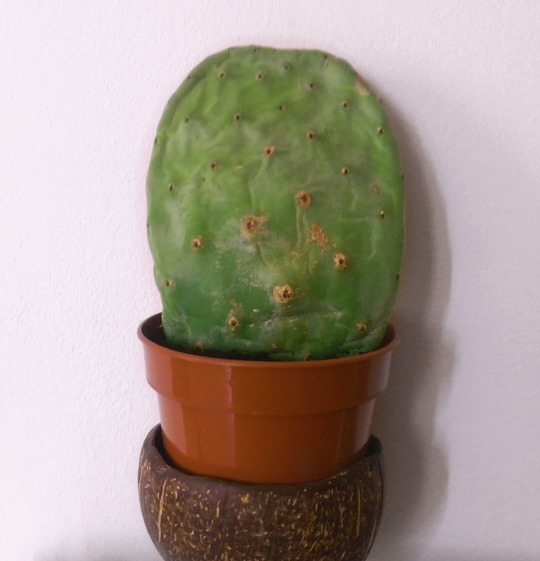
While I was taking photos I noticed a pad was laying detached, quite dry, curled up on itself and failing to root. It came home to Scotland with me, I flattened it down for a few days with the help of some heavy botany books and potted it up. Still a bit wrinkly, but It looks much happier now!
#opuntia#opuntia stricta#nopal#compact prickly pear#prickly pear#cactaceae#fico d'india#cactus#cacti#flowers#plant identification#plant photography#botany#plantblr#gardeners on tumblr#edible plants#italy#liguria#beach#seaside#summer#plant propagation#tbt#throwback#throw back thursday
185 notes
·
View notes
Text


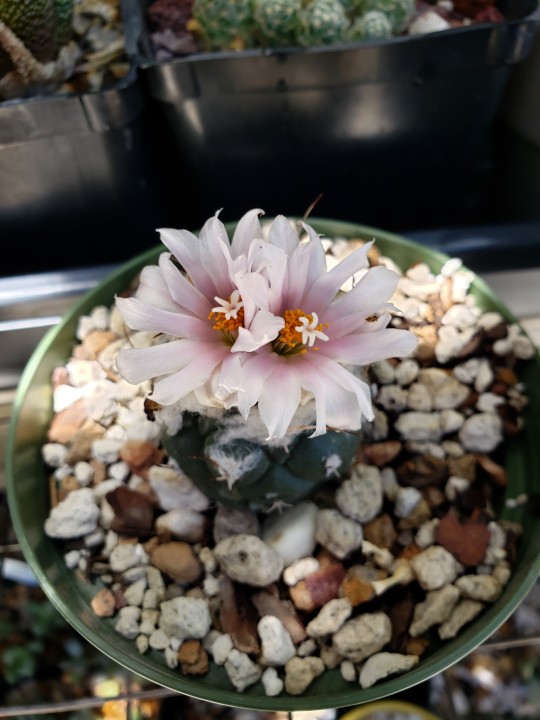
Various cacti blooms
From left to right: gymnocalycium horstii, opuntia stricta, and turbinicarpus lophophoroides
5 notes
·
View notes
Text
INVESTIGATING THE SYNERGISTIC EFFECTS OF MORINGA OLEIFERA SEED CAKE EXTRACT AND OPUNTIA STRICTA (CACTUS) MUCILAGE IN SURFACE WATER TREATMENT
INVESTIGATING THE SYNERGISTIC EFFECTS OF MORINGA OLEIFERA SEED CAKE EXTRACT AND OPUNTIA STRICTA (CACTUS) MUCILAGE IN SURFACE WATER TREATMENT
INVESTIGATING THE SYNERGISTIC EFFECTS OF MORINGA OLEIFERA SEED CAKE EXTRACT AND OPUNTIA STRICTA (CACTUS) MUCILAGE IN SURFACE WATER TREATMENT
Abstract:
This research investigated the synergistic effects of Moringa oleifera seed cake extract andOpuntia stricta(cactus) mucilage in surface water purification.The synergistic effects of the two coagulants on turbidity,conductivity, total dissolved…
View On WordPress
#CAKE EXTRACT#INVESTIGATING THE SYNERGISTIC EFFECTS OF MORINGA OLEIFERA SEED CAKE EXTRACT AND OPUNTIA STRICTA (CACTUS) MUCILAGE IN SURFACE WATER TREATMENT#MORINGA OLEIFERA SEED#OPUNTIA STRICTA#SURFACE WATER TREATMENT
0 notes
Photo
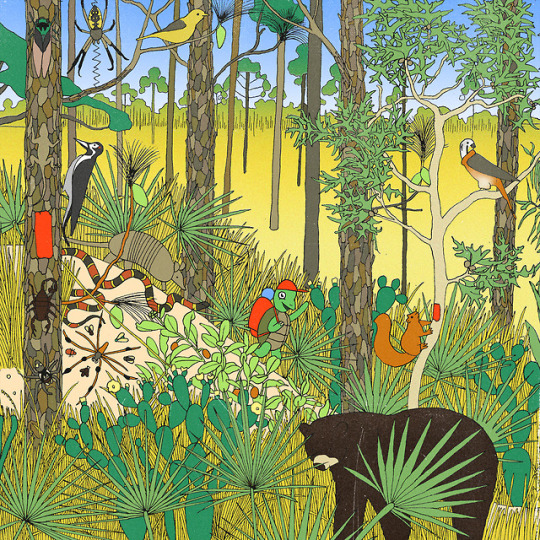
4/5 of the ecosystems I’ve illustrated for the Florida Trail Association! This one is the xeric sandhill scrub, which is common throughout north and central Florida, like the Juniper Prairie Wilderness in Ocala National Forest.
Species listed:
Fauna
Twin-flagged jumping spider (Anasaitis canosa)
Black and yellow garden spider (Argiope aurantia)
Golden orbweaver spider (Nephila clavipes)
Dog-day cicada (Tibicen canicularis)
Florida bark scorpion (Centruroides gracilis)
Fence lizard (Sceloporus undulatus)
Eastern coral snake (Micrurus fulvius)
Red-cockaded woodpecker (Picoides borealis)
Southeastern kestrel (Falco sparverius paulus)
Pine warbler (Setophaga pinus)
Florida black Bear (Ursus americanus floridanus)
Eastern gray squirrel (Sciurus carolinensis)
Flora
Gopher apple (Licania michauxii)
Prickly Pear Cactus (Opuntia austrina)
Longleaf Pine (Pinus palustris)
Saw Palmetto (Serenoa repens)
Turkey Oak (Quercus laevis)
Wiregrass (Aristida stricta)
13 notes
·
View notes
Photo
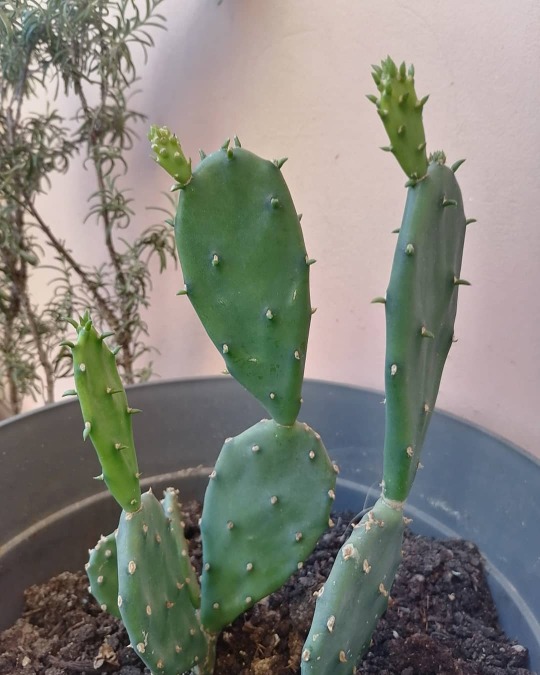
Nuove pale per la mia Opuntia stricta! . . #opuntia #opuntiastricta #opuntiacactus #cactus #cactusmania #cactusmania #cactusysuculentas #succulente #succulents #succulentlove #succulentsofinstagram #succulentobsession #succulentslovers #instasucculents https://www.instagram.com/p/CTAD2xWMphK/?utm_medium=tumblr
#opuntia#opuntiastricta#opuntiacactus#cactus#cactusmania#cactusysuculentas#succulente#succulents#succulentlove#succulentsofinstagram#succulentobsession#succulentslovers#instasucculents
0 notes
Text


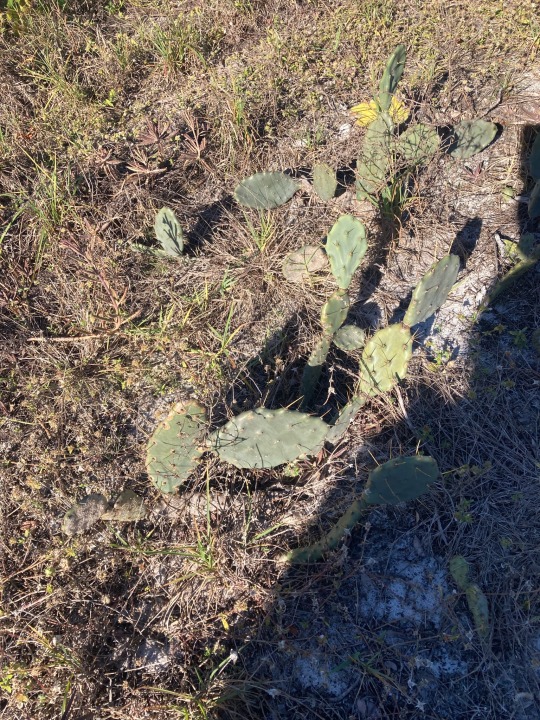

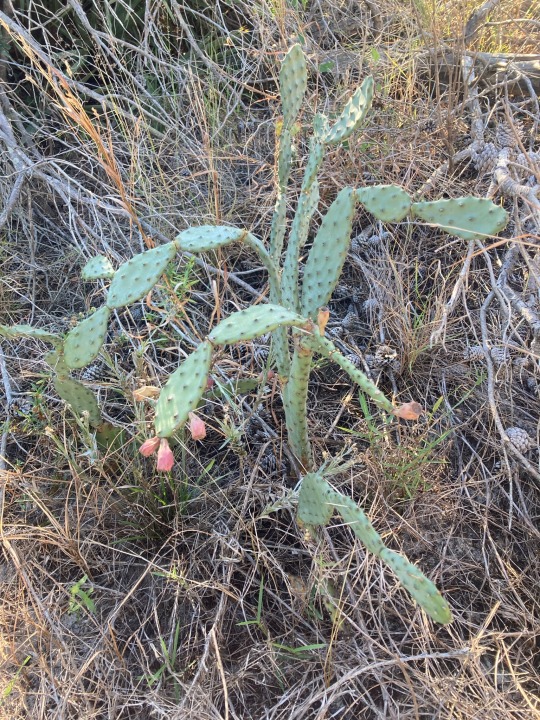
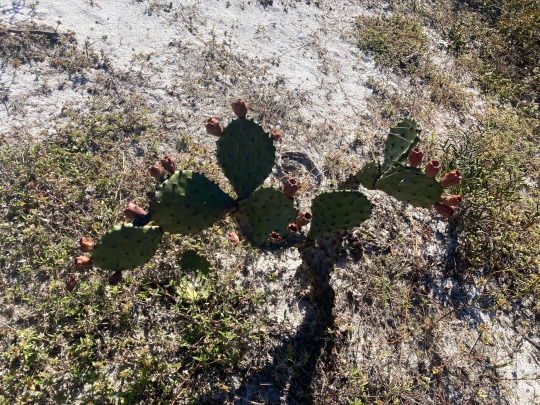
no one ever IDed any of then even though i felt like i got some decent closeup shots but heres every prickly pear i saw on a native plant society field trip earlier this month. our goal was to look for bees but the cold snap hit and there were no bees out
im sure the one covered in Kalanchoes is Opuntia stricta, and i posted it before, but i dont know any of the others
i will say once more, if you can get me Opunitia stricta pads, ill die for you/kill for you/pay you money for them/etc. i want that species soooo bad but every attempt to buy them has been unsuccessful and its been years since ive seen one growing somewhere that taking a pad would be acceptable
1 note
·
View note
Text
Bryophyllum pinnatum (abamoda) – Punch Newspapers
Bryophyllum pinnatum is a fleshy herb rising up 120cm within the household crassulaceae.The leaves are easy or trifoliolate with petioles. They’re inexperienced with purple serrated margins that are able to producing new crops vegetatively when it falls to the bottom. The flowers are dropping in lax panicles with an inflated tubular calyx. It’s native to Madagascar. It’s a priceless medicinal in addition to decorative plant. It’s known as Abamoda in Yoruba. It’s popularly known as miracle leaf, life plant and by no means die.
Earlier than I proceed, I’ll prefer to share a analysis I discovered. I’ll attempt to simplify it. This examine by Robert Kelechi Obi et al was designed to research the antiviral potential of Bryophyllum pinnatum and Viscum album. Contemporary leaves of those crops had been collected and dried. Extraction was achieved with methanol. Measles (MV), polio PV and yellow fever (YFV) viruses had been remoted from their respective vaccines, whereas herpes simplex virus-1 (HSV-1) was remoted from a constructive HSV-1 male case. Outcomes of the antiviral evaluation confirmed that two of the viruses had been prone to B. pinnatum (L.) and V. album (L.). Whereas HSV-1 was delicate to B. pinnatum (L.), MV was prone to V. album. The PV and YFV had been proof against each crops extracts on the identical concentrations.
The conclusion of the examine reads “this examine has proven that the answer to the worldwide menace of MV and HSV-1 viral ailments might be discovered within the forest zones of Nigeria.” Regardless of great progress in human drugs, no medicine exist for the whole remedy of viral ailments however right here we’re seeing that our personal abamoda is an answer to measles and herpes viruses! This must be a pointer to the truth that the remedy for COVID 19 pandemic may be within the wild!
Whereas getting ready for this, I visited an aged lady within the neighbourhood. I noticed the plant in her home, plucked a leaf, washed and chewed. The pinnacle of Herbarium, Pharmacognosy Division on the Obafemi Awolowo College, Ile-Ife, Osun State, Mr Ife Ogunlowo, shared some experiences in regards to the plant with me. A baby cried all by means of the evening, the kid couldn’t be taken to the hospital due to the space. A steamed leaf of the plant was positioned on the brow of the kid and in a couple of minutes, the kid slept off. He additionally instructed me he used the plant to resolve the headache downside of one in all his college students.
I spoke with one other individual. Her title is Evangelist Calista Oke. She additionally confirmed to me that the plant is used on child’s navels.
The plant is standard in folklore drugs. It has been used for the remedy of quite a lot of circumstances equivalent to rheumatism, cough, bronchial asthma, tonsillitis, diarrhoea, physique ache, arthritis, heartburn, pores and skin ulcers, peptic ulcer, diabetes mellitus and microbial infections. It’s utilized to wounds, boils and bug bites. In Nigeria, the plant is especially recognized for its efficient wound therapeutic properties and detachment of the umbilicus of infants. Cough drugs is comprised of the roots in Sierra Leone. Heated leaves are used for swellings and abscesses in Jamaica. It’s used for rheumatoid arthritis, bruises, burns and ulcers in China. Within the KwaZulu-Natal Province, South Africa, the leaves are utilized in mixture with Opuntia stricta and Euphorbia hypericifolia to deal with gonorrhea.
Pharmacological research on it reported a number of organic actions, a few of which may authenticate the plant’s conventional makes use of together with immunomodulatory, CNS depressant, analgesic, anti-inflammatory, anti-microbial, anti-tumour, anti-ulcer, insecticidal, anti-diabetic, anti-convulsant, antioxidant and anti-hypertensive properties. Research have additionally reported a variety of energetic phytochemicals equivalent to alkaloids, triterpenes, glycosides flavonoids,steroids, bufadienolides, lipids and natural acids. These compounds have been thought-about to be liable for the plant’s various pharmacological actions.
In lots of instances, B. pinnatum leaves had been soaked in chilly water in a single day, boiled in water, squeezed or roasted and the extracts obtained to deal with illnesses. Additionally it is consumed as tea and blended into juices or eaten uncooked. The plant is a blood air purifier and it’s a well-known drugs to remedy kidney stones. The foundation is used to deal with hypertension and in addition to stop any sort of cardiac downside. The leaf is used for the remedy of fever. The extract of the plant is used for the remedy of roundworms. Utilizing the juice of this plant as ear drop heals ear ache. The foundation is believed to guard the liver and has confirmed to be helpful for the remedy of hepatitis. It’s a diuretic. Due to its antioxidant property, the plant is used within the combination of natural inexperienced tea. It’s used as a house treatment for piles (Haemorrhoids).The leaf juice is used for the remedy of abdomen ache. Extract of the plant is used for the nourishment of the hair and for treating grey hair. The leaves are used for intestinal issues. The paste is used for leucorrhoea. Contemporary juice of this plant can be utilized to deal with jaundice.
As a result of it’s used historically in ethnomedicinal practices for the remedy of kidney stone and urinary insufficiency, this declare was put to check in a examine titled, “Bryophyllum pinnatum Leaf Extracts Stop Formation of Renal Calculi in Lithiatic Rats by Mahendra Yadav et al.” The conclusion is that Bryophyllum pinnatum leaves confirmed preventive impact in opposition to renal calculi formation and validates its ethnomedicinal use in urinary issues. It additional helps its therapeutic potential for the remedy of urinary calculi (Renal or urinary calculi additionally known as urolithiasis is a situation which entails the method of formation and retention of stone(s) in kidney, bladder and/or urethra that ends in renal colic, urine retention and ache within the stomach and flank).In one other examine titled. “Antimicrobial and antioxidant exercise of kaempferol rhamnoside derivatives from Bryophyllum pinnatum” by Simplice Joel Ndendoung Tatsimo et al, the conclusion is that findings within the examine reveal that Bryophyllum pinnatum and a few of its remoted compounds have fascinating antimicrobial and antioxidant properties and due to this fact confirming the standard use of B. pinnatum within the remedy of infectious and free radical damages.
Like I all the time say, the usage of crops should not be abused. This plant have to be utilized in moderation. It turns into clearer daily that nature harbours a wealth of invaluable sources for humanity. We’ve got merely scratched the tip of the iceberg.
Copyright PUNCH.
All rights reserved. This materials, and different digital content material on this web site, is probably not reproduced, printed, broadcast, rewritten or redistributed in complete or partly with out prior specific written permission from PUNCH.
Contact: [email protected]
DOWNLOAD THE PUNCH NEWS APP NOW ON


window.fbAsyncInit = operate() {
FB.init({
appId : ‘{1062006247266215}’,
xfbml : true,
model : ‘v2.11’
});
FB.AppEvents.logPageView();
};
(operate(d, s, id){
var js, fjs = d.getElementsByTagName(s)[0];
if (d.getElementById(id)) {return;}
js = d.createElement(s); js.id = id;
js.src = “https://join.fb.internet/en_US/sdk.js”;
fjs.parentNode.insertBefore(js, fjs);
}(doc, ‘script’, ‘facebook-jssdk’));
Source link
source https://fikiss.net/bryophyllum-pinnatum-abamoda-punch-newspapers/
Bryophyllum pinnatum (abamoda) – Punch Newspapers published first on https://fikiss.net/
from Karin Gudino https://karingudino.blogspot.com/2021/01/bryophyllum-pinnatum-abamoda-punch.html
0 notes
Text
An important assessment of invasive plants in Kenya

- By CABI -
CABI (Centre for Agriculture and Bioscience International) scientists have led the first assessment of naturalised, invasive and potentially invasive plant species present in Laikipia County, Kenya, which hosts the highest populations of endangered large mammals in the country.
The research led by Dr Arne Witt suggests that a range of invasive alien plants pose a series risk to the County – home to the second-highest number of endangered wildlife in East Africa including elephant, rhino, Grevy’s zebra, reticulated giraffe and wild dogs.
Together with CABI colleagues Winnie Nunda and Tim Beale along with help from Dr Darren Kriticos of the University of Queensland, Australia, Dr Witt argues that without efforts to eradicate, contain, or control invasive plant species in Laikipia County many rare and iconic wildlife species may be lost.
As outlined in the journal Koedoe: African Protected Area Conservation and Science, the researchers strongly advocate the use of biological controls as cost effective, safe and environmentally sustainable ways to manage some of the invasive plants as part of an integrated management plan.
Broadscale roadside surveys were carried out in Laikipia County, to record all naturalised and invasive species. This data was supplemented by CLIMEX eco-climatic niche models of nine species that the scientists consider to pose the biggest threat to conservation initiatives in the East African region.
Widespread species in the County included Opuntia stricta, O. ficus-indica, Austrocylindropuntia subulata and other succulents. Of the 145 alien plant species recorded, 67 and 37 (including four species of uncertain origin) were considered to be already naturalised or invasive, respectively, and a further 41 species had been recorded as being naturalised or invasive outside of Laikipia. Most (141) of these species were introduced as ornamentals only or had uses in addition to being ornamentals, with the majority (77) having their origins in tropical America.
Based on the current eco-climatic conditions, most of Laikipia is unsuitable for Chromolaena odorata, marginally suitable for Mimosa pigra and Lantana camara, and a better climatic match, ranked from least to most favourable, for Tithonia diversifolia, Cryptostegia grandiflora, Parthenium hysterophorus, Prosopis juliflora, O. stricta, and Parkinsonia aculeata.
Dr Witt said, "The County is home to the second-highest abundance of wildlife in East Africa, after the Mara-Serengeti ecosystem, and hosts the highest populations of endangered large mammals in Kenya.
"Alien plant invasions pose significant threats to conservation and livelihoods in Laikipia. As such, it would be prudent to develop and implement management strategies to reduce the threats of all invasive and potentially invasive plant species.
"It is imperative that all naturalised, invasive and potentially invasive plant species be removed from the grounds of all tourist facilities and possibly also villages that fall within areas where the main land-use practice is livestock production and conservation.

Diagram: Maps showing the distribution of nine of the most widespread invasive plant species in Laikipia County, Kenya. Credit: Koedoe: African Protected Area Conservation and Science.
"Those plants which have already escaped cultivation should be eradicated, if possible, or their further spread contained. Finally, biological control solutions for widespread and abundant species should be implemented wherever possible, as has been done for O. stricta and initiated for O. engelmannii."
Dr Witt added that there are many benefits to the use of biological controls including the fact that many agents establish self-perpetuating populations, often across the whole range of the target species, and most projects only require a one-off investment.
"There are a number of widespread and abundant invasive plant species in Laikipia that could be targeted for biological control," he said. "The cochineal Dactylopius opuntiae (Cockerell) 'stricta' biotype (Dactylopiidae), recently introduced for the control of O. stricta, is already established in Laikipia. Species such as O. ficus-indica and O. monacantha have also been brought under good control through the introduction of cochineal in the last century."
Permission is currently being sought from the regulatory authorities to introduce another biotype of D. opuntiae for the control of O. engelmannii. Cereus jamacaru has also been brought under good biological control in South Africa, an option should this species become invasive, although populations are currently such that it can still be eradicated in Laikipia.
--
Source: CABI
Full study: “A preliminary assessment of the presence and distribution of invasive and potentially invasive alien plant species in Laikipia County, Kenya, a biodiversity hotspot”, Koedoe: African Protected Area Conservation and Science.
http://dx.doi.org/10.4102/koedoe.v62i1.1605
Read Also
Amazon forest: Disturbance is changing how plants are dispersed
0 notes
Photo
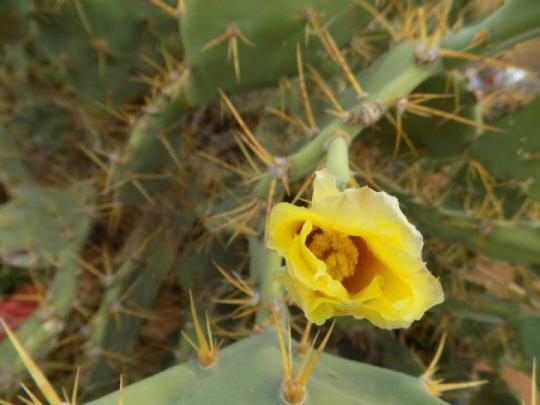
Le biocontrôle le plus rentable dans la lutte contre la poire nuisible commune Opuntia stricta
0 notes
Photo



Prickly Pear Cacti (Opuntia stricta)
Sand Ridge State Forest
Forest City, Il
September 9th, 2017
32 notes
·
View notes
Photo

Opuntia stricta (Opuntia dillenii)
Los cactus conocidos como nopales son plantas de muy rápido crecimiento que, dependiendo de la especie, producen frutos que están…
Sigue leyendo en https://www.jardineriaon.com/opuntia-dillenii.html
0 notes